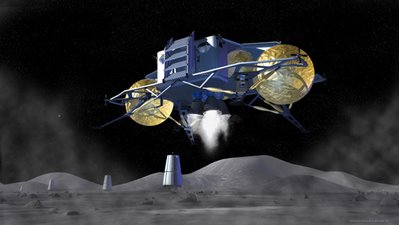 NASA has long been committed to returning to the moon on a regular basis by 2020. What they were unclear on is what exactly they would do after that.
NASA has long been committed to returning to the moon on a regular basis by 2020. What they were unclear on is what exactly they would do after that.
Now we know.
NASA unveiled plans yesterday to set up a small and ultimately self-sustaining settlement of astronauts at the south pole of the moon sometime around 2020 -- the first step in an ambitious plan to resume manned exploration of the solar system.
The long-awaited proposal envisions initial stays of a week by four-person crews, followed by gradually longer visits until power and other supplies are in place to make a permanent presence possible by 2024.
The south pole was chosen for several reasons, notably the suspected presence of water ice and the fact that it's almost always in sunlight -- an important consideration since the station will be largely solar-powered.
Why go? Well, beyond the scientific reasons, a permanent base on the moon would be both a demonstration project for extraterrestrial habitation and a first step toward exploring and eventually colonizing the rest of the solar system. It could be used as a way station and refueling point for expeditions to Mars, for instance, reducing the amount of mass such missions would need to lift out of Earth's gravity well. Looking way ahead, a truly self-sustaining colony could perform a lot of heavy industrial tasks -- mining, refining, even spaceship construction -- without needing to worry about pollution and in much lighter gravity.
In addition, the base would have relatively easy access to the dark side of the moon. Beyond learning more about that poorly understood area, the far side would make an excellent place to set up gigantic telescopes -- far bigger than anything we can orbit and far more sensitive than any Earthbound observatory, which must contend with distortions caused by atmosphere and light pollution.
It won't be cheap -- $100 billion or so over the next 20 years -- but given the time frame and the potential payoffs, it's worth it. It certainly will provide far more return on capital than, say, blowing $500 billion in a horribly mismanaged war. Or $400 billion on a badly designed prescription-drug plan.
And if the international fusion reactor project pans out, the moon base could eventually use all the Helium-3 lying about to provide hot showers.
space, science, moon, NASA, politics, midtopia

4 comments:
We can hope....
Probably my single regret about my life is going to be the fact that space exploration will happen long after I am dead (even if science does some sort of "rejuv" within the next 50 years).
Oh well, can't have everything I guess....
Yeah, me too. I write science fiction on the side (only one sale so far, but more pending) and some of the things I write about feel so close.... and yet I'll likely miss them by 20 years or so.
I'm thankful that if I live out my normal life expectancy I'll be able to witness a permanent moon station, perhaps the harnessing of fusion power, and the construction of gigantic telescopes on the moon. A manned mission to Mars or Titan or Europa or such would be far cooler, but I suspect I'm going to miss out on that unless the pace of technology and exploration accelerates after the moon landings.
Hey, you've got one more sale than I have then! I write fantasy more than sci-fi though.
IF science gets a decent rejuv solution going within the next 25 years, and IF my health (excellent at this point - especially considering that I'm just a year shy of 60) remains excellent, I have no doubt I'll do whatever's necessary to pay for the treatments.
Buncha big IFs there though....
Interim step will probably involve cloning you, copying your brain and downloading your memories into the new body....
Keep on writing. Perseverance pays off.... something I have to keep telling myself as I try to squeeze writing time in between family, work and this site.
Post a Comment